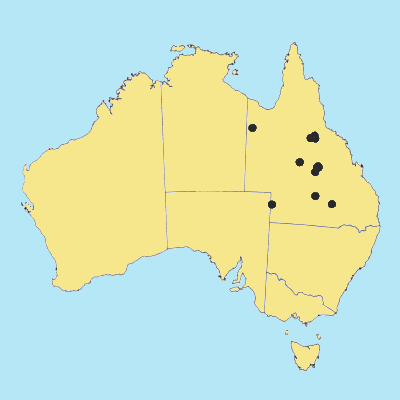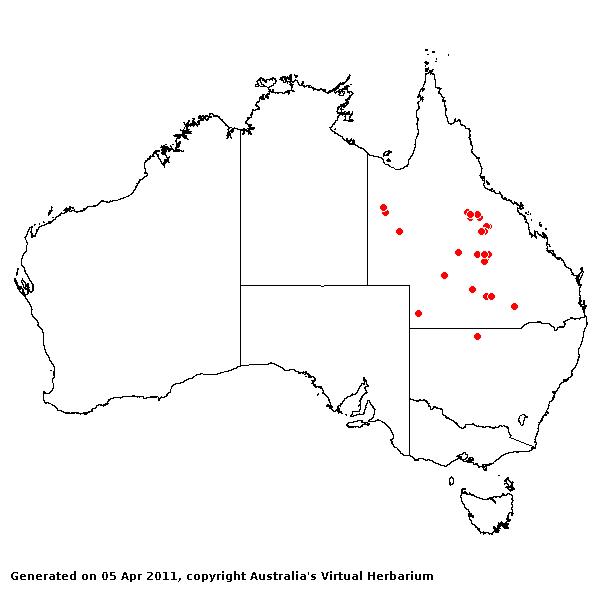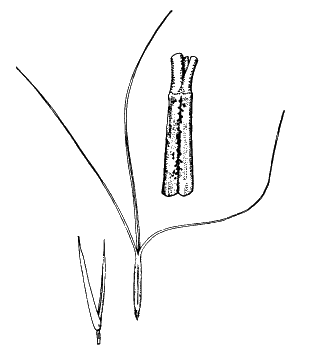Aristida helicophylla S.T.Blake. Proc.
Roy. Soc. Qld 51: 171, t.4, figs 8–12 (1940).
Classification. (GPWG 2001) : Subfamily Aristidoideae. Aristideae.
Type of Basionym or
Protologue Information: Queensland: Warrego District: between Charleville
& Westgate, 20 Apr 1934, on red sand associated with Eucalyptus
melanophloia & Triodia, S. T. Blake 5411 (HT: BRI; IT: BRI, CANB, K,
MEL).
Key references
(books and floras): [1981] M.Lazarides in J.Jessop (ed)., Flora of
Central Australia (449), [2002] D.Sharp & B.K.Simon, AusGrass,
Grasses of Australia, [2008] S.W.L.Jacobs, R.D.B.Walley &
D.J.B.Wheeler, Grasses of New South Wales (128).
Illustrations:
[1983] J.C.Tothill & J.B.Hacker, Grasses of Southern Queensland
(104(16)), [2008] S.W.L.Jacobs, R.D.B.Whalley & D.J.B.Wheeler, Grasses
of New South Wales, 4th edn (128).
Derivation: Gk.
helix, twisted; phyllon, leaf. Old leaf-blades curled in the
manner of a watch-spring.
Habit.
Perennial. Culms 70–150 cm tall. Mid-culm internodes glabrous. Lateral branches
sparsely branched or branched. Leaf-sheaths glabrous on surface. Ligule a
fringe of hairs, 0.5–1 mm long. Leaf-blades curled, flat or conduplicate or
involute or convolute, 10–21 cm long, 2–3 mm wide.
Inflorescence.
Inflorescence compound, a panicle. Panicle lanceolate, 12–32 cm long, 1.5–4 cm
wide.
Spikelets.
Spikelets pedicelled. Fertile spikelets 1-flowered, comprising 1 fertile
floret(s), without rachilla extension, lanceolate, terete, 6–8 mm long.
Glumes.
Glumes similar, thinner than fertile lemma. Lower glume lanceolate, membranous,
keeled, 1-keeled, 1 -nerved. Lower glume surface glabrous. Lower glume apex
mucronate. Upper glume lanceolate, 6–8 mm long, membranous, keeled, 1-keeled, 1
-nerved. Upper glume surface smooth to scabrous, glabrous. Upper glume apex
entire or erose, mucronate.
Florets.
Fertile lemma 4–5.5 mm long, without keel, 3 -nerved. Lemma apex awned, 3
-awned. Median (principal) awn pseudo-articulate at base, without a column.
Lateral lemma awns present. Palea without keels. Anthers 3. Grain 3 mm long.
Continental
Distribution: Australasia.
Australian
Distribution: Queensland.
Queensland:
Burke, Mitchell, North Kennedy, Warrego, South Kennedy, Gregory South, Maranoa.
Notes.
A. helicophylla is similar to A. inaequiglumis and A. ingrata
in having a pseudoarticulation but has much smaller spikelets than these
species. Furthermore it differs from A. inaequiglumis by the glumes not
being markedly dissimilar in length and from A. ingrata by the muricate
lemma furrow.
Scattered
areas in arid Queensland. Acacia, and Eucalyptus communities on
red earths, sands and alluvial soils. Flowering and fruiting March to April,
June to July, October.



